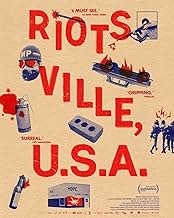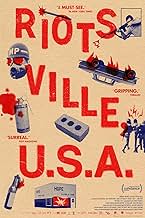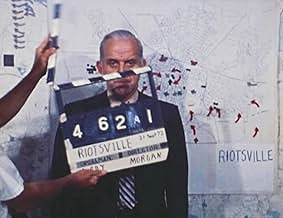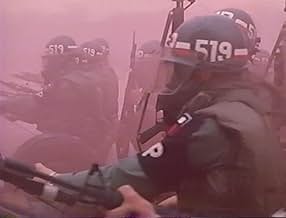Welcome to Riotsville, a fictional town built by the US military. Using all archival footage, the film explores the militarization of the police and creates a counter-narrative to the nation... Read allWelcome to Riotsville, a fictional town built by the US military. Using all archival footage, the film explores the militarization of the police and creates a counter-narrative to the nation's reaction to the uprisings of the late '60s.Welcome to Riotsville, a fictional town built by the US military. Using all archival footage, the film explores the militarization of the police and creates a counter-narrative to the nation's reaction to the uprisings of the late '60s.
- Awards
- 4 wins & 10 nominations total
Charlene Modeste
- Voiceover
- (voice)
Lyndon B. Johnson
- Self
- (archive footage)
Otto Kerner
- Self - Chairman
- (archive footage)
- (as Governor Otto Kerner)
Edward P. Morgan
- Self - PBL Chief Correspondent
- (archive footage)
Robert Curvin
- Self - Former Chairman, Neward CORE
- (archive footage)
Leonard Kowalewski
- Self - Newark Police
- (archive footage)
John Harrington
- Self - Fraternal Order of Police
- (archive footage)
- (as Sgt. John Harrington)
Albert Cleage
- Self
- (archive footage)
- (as The Rev. Albert Cleage)
Alvin F. Poussaint
- Self - Tufts University
- (archive footage)
- (as Dr. Albert Poussaint)
Fred Harris
- Self - Commission Member
- (archive footage)
- (as Sen. Fred R Harris)
Dick Gregory
- Self
- (archive footage)
Roger Mudd
- Self
- (archive footage)
Robert Byrd
- Self
- (archive sound)
- (as Senator Robert Byrd)
Jimmy Collier
- Self
- (archive footage)
Frederick Douglass Kirkpatrick
- Self
- (archive footage)
- (as Rev. Frederick Douglass Kirkpatrick)
Ronald Reagan
- Self
- (archive footage)
Spiro Agnew
- Self
- (archive footage)
- (as Gov. Spiro Agnew)
Strom Thurmond
- Self
- (archive footage)
- (as Sen. Strom Thurmond)
- Director
- Writer
- All cast & crew
- Production, box office & more at IMDbPro
Featured reviews
Originally premiered at the 2022 Sundance Film Festival in the NEXT selection.
Director Sierra Pettengill makes a documentary about a fictional town named Riotsville which was built by the US military and explores the militarization of the police and creates a counter-narrative to the nation's reaction to the uprisings of the late '60s. The issues of police and riots are still a very common theme in the modern days. This documentary may be considered relevant in todays time because of all the political things happening at this very moment.
The music choice to create an uneven tension really helps to make you feel uneasy of what you are learning, the narration from Charlene Modeste does really help to add an feeling of uneasiness while you are witnessing archival footage of riots and insane things happening. There are some really good conversations from political members, citizens, news people, and others that are presented in this documentary to capture a realistic point of view.
However, the editing becomes really sloppy and some of the technical moments are noticeably bad. As if there are some errors during post-production when making this movie. Overall, a good documentary.
Rating: B.
Director Sierra Pettengill makes a documentary about a fictional town named Riotsville which was built by the US military and explores the militarization of the police and creates a counter-narrative to the nation's reaction to the uprisings of the late '60s. The issues of police and riots are still a very common theme in the modern days. This documentary may be considered relevant in todays time because of all the political things happening at this very moment.
The music choice to create an uneven tension really helps to make you feel uneasy of what you are learning, the narration from Charlene Modeste does really help to add an feeling of uneasiness while you are witnessing archival footage of riots and insane things happening. There are some really good conversations from political members, citizens, news people, and others that are presented in this documentary to capture a realistic point of view.
However, the editing becomes really sloppy and some of the technical moments are noticeably bad. As if there are some errors during post-production when making this movie. Overall, a good documentary.
Rating: B.
This film struggles with some fascinating archival footage and trying to stretch both the length and message of the film too broadly around that.
This country struggles with civil rights sadly over and over again, now to the point where the one thing uniting far too many citizens is an unwavering distrust of the government. Documenting protests is important in understanding both the strength and vulnerability of the not-always-so-United States. That said I feel like any assembly of mobs...protesters (also I guess anti-protesters generally few but vociferous) and then the police force can bring out the mob mentality on both sides.
In general color me wary of both, but especially the ones where everyone in the mob has a gun.
Anyways this film might best be served by watching the trailer or a sped-up or excerpted version of it. I assume the abridged version won't have the slow zoom and defocus on pixelated faces. Although that would do a disservice to DJ Rupture's excellent soundtrack work.
Looking forward... 1) Well I do think for all of the struggles, the arc or the USA does bend towards a better country...often painfully and painfully slowly.
2) The notion of test cities for police exercises is still going on afaik, didn't the former Blackwater corporation utilize them recently before they re-branded or whatever?
3) Sierra Pettengill might be an excellent resource for gathering archival footage for other directors' projects. I see she was part of the team for the Jarmusch documentary on the The Stooges (with Iggy that is, not Curly).
I struggle to recommend this, but with expectations lowered for less of an expose and more of an art collage meditation with occasional Gulf advertisements - it might be worth an hour of your time, although the running time is 1.5 hours.
This country struggles with civil rights sadly over and over again, now to the point where the one thing uniting far too many citizens is an unwavering distrust of the government. Documenting protests is important in understanding both the strength and vulnerability of the not-always-so-United States. That said I feel like any assembly of mobs...protesters (also I guess anti-protesters generally few but vociferous) and then the police force can bring out the mob mentality on both sides.
In general color me wary of both, but especially the ones where everyone in the mob has a gun.
Anyways this film might best be served by watching the trailer or a sped-up or excerpted version of it. I assume the abridged version won't have the slow zoom and defocus on pixelated faces. Although that would do a disservice to DJ Rupture's excellent soundtrack work.
Looking forward... 1) Well I do think for all of the struggles, the arc or the USA does bend towards a better country...often painfully and painfully slowly.
2) The notion of test cities for police exercises is still going on afaik, didn't the former Blackwater corporation utilize them recently before they re-branded or whatever?
3) Sierra Pettengill might be an excellent resource for gathering archival footage for other directors' projects. I see she was part of the team for the Jarmusch documentary on the The Stooges (with Iggy that is, not Curly).
I struggle to recommend this, but with expectations lowered for less of an expose and more of an art collage meditation with occasional Gulf advertisements - it might be worth an hour of your time, although the running time is 1.5 hours.
It was disappointing to watch what should have been a worthwhile project. In terms of the footage presented, we see way more outtakes than the actual controversial enactments of the staged "riots" for the benefit of an audience of Generals and Politicians.
The one thing that seemed to be a revelation was that the idea of Snipers was actually one which was fabricated by the police in order to show that they should bring in heavy artillery, but the reality is that the snipers were just police plants shooting wildly, even at each other to invoke a response -- there was only one case of an unknown sniper who attempted to shoot at the police while drunk, and so the sniper missed every target.
But the problem with the documentary is the frequent use of non-essential footage, "padding" the scenes with news commentators prattle, and often playing TV logos and even a commercial or promotional tape in order to add commentary on the alignment of the news media, only to miss the target much like the sniper -- the commercials, as much as they are nostalgic and naive, are wasted material in the otherwise over-long project. Cutting out 30 minutes of this wasted footage would have better served the filmmaker's goal.
Of course, then it would not be considered a contender for a Feature by the Academy, which one senses is the filmmaker's attitude in this presentation -- as evidenced by the use of overly dramatic voice-over consisting of poetic nonsense.
Since the filmmaker sees the found footage as so extraordinary, we are intrigued by the idea that we might then be able to see the actual riot footage of the real events, such as the Democratic National Convention in 1968, but none of this happens, and instead we are given a somewhat watered down version of the event at the Republican National Convention the same year when Richard Nixon was nominated -- and the protest by a small group of black ghetto denizens was a complete and utter failure.
The one thing that seemed to be a revelation was that the idea of Snipers was actually one which was fabricated by the police in order to show that they should bring in heavy artillery, but the reality is that the snipers were just police plants shooting wildly, even at each other to invoke a response -- there was only one case of an unknown sniper who attempted to shoot at the police while drunk, and so the sniper missed every target.
But the problem with the documentary is the frequent use of non-essential footage, "padding" the scenes with news commentators prattle, and often playing TV logos and even a commercial or promotional tape in order to add commentary on the alignment of the news media, only to miss the target much like the sniper -- the commercials, as much as they are nostalgic and naive, are wasted material in the otherwise over-long project. Cutting out 30 minutes of this wasted footage would have better served the filmmaker's goal.
Of course, then it would not be considered a contender for a Feature by the Academy, which one senses is the filmmaker's attitude in this presentation -- as evidenced by the use of overly dramatic voice-over consisting of poetic nonsense.
Since the filmmaker sees the found footage as so extraordinary, we are intrigued by the idea that we might then be able to see the actual riot footage of the real events, such as the Democratic National Convention in 1968, but none of this happens, and instead we are given a somewhat watered down version of the event at the Republican National Convention the same year when Richard Nixon was nominated -- and the protest by a small group of black ghetto denizens was a complete and utter failure.
The trailer for this movie focused on the fake towns - they look like movie sets - that were built in the 1960s so that the Army could practice dealing with "race riots."
As it turns out in the movie, there were only two such Riotsvilles, and they play only a very small roll in this movie. That's very unfortunate, imo. I would have liked to know how they were financed - did Congress know about them? - how the soldiers were chosen to stage crowd control in them, etc. In other words, I would have appreciated it if the movie had concentrated on the riotsvilles.
Instead, most of the movie deals with the Civil Rights Movement and white reaction to it in the 1960s. That's interesting, of course, but nothing new. Sometimes it really seemed like filler for a movie that should have been a short rather than a feature-length film.
The narration got a little shrill at times for my tastes. The images and newsreel footage that are the basis of this movie are already powerful, and speak for themselves Since no one opposed to the Civil Rights Movement is going to watch this movie, there's no point in preaching to the already converted.
An ok movie, in short, but not enough new material to warrant its 91 minute run time.
As it turns out in the movie, there were only two such Riotsvilles, and they play only a very small roll in this movie. That's very unfortunate, imo. I would have liked to know how they were financed - did Congress know about them? - how the soldiers were chosen to stage crowd control in them, etc. In other words, I would have appreciated it if the movie had concentrated on the riotsvilles.
Instead, most of the movie deals with the Civil Rights Movement and white reaction to it in the 1960s. That's interesting, of course, but nothing new. Sometimes it really seemed like filler for a movie that should have been a short rather than a feature-length film.
The narration got a little shrill at times for my tastes. The images and newsreel footage that are the basis of this movie are already powerful, and speak for themselves Since no one opposed to the Civil Rights Movement is going to watch this movie, there's no point in preaching to the already converted.
An ok movie, in short, but not enough new material to warrant its 91 minute run time.
But this was far below what i expected from a historical perspective. Its the black and white stigmata over and over again, and what really should be delved with, namely how antiriot enforcement where thought to be and how it came to be in the name of riotsville usa drowns in a claustrophobic, cataclysmic psychedelic epileptic triggering lightshows and overfocused still, and a neoneoneoultra composed musical scored( like norwegian composer arne nordheim) makes this a complete rotten mess historywise. Its narrative voice never tells how much was spended or how large this antiriotforce buildup was, and the real riots that couldve made this documentary a real document of history lacks completely.
So if this is how riots have been handled over the years then its time to look somewhere else. As a filmproduct it lacks quality on most bases, and the amount of positive criticism over a ribbed and untelling way to tell a story that has been told here really feels fictitious. The grumpy old man doesnt recommend this one, and will cry out a call to the big documentarymakers to make a series about the real rioting 60's and the real face of the crammed crow.
So if this is how riots have been handled over the years then its time to look somewhere else. As a filmproduct it lacks quality on most bases, and the amount of positive criticism over a ribbed and untelling way to tell a story that has been told here really feels fictitious. The grumpy old man doesnt recommend this one, and will cry out a call to the big documentarymakers to make a series about the real rioting 60's and the real face of the crammed crow.
- How long is Riotsville, U.S.A.?Powered by Alexa
Details
- Release date
- Country of origin
- Official site
- Language
- Also known as
- Riotsville, USA
- Production companies
- See more company credits at IMDbPro
Box office
- Gross US & Canada
- $40,960
- Opening weekend US & Canada
- $5,597
- Sep 18, 2022
- Gross worldwide
- $44,392
- Runtime1 hour 31 minutes
- Color
Contribute to this page
Suggest an edit or add missing content

























